
Locality: Tower Hill Rhodonite Locale, Hinsdale, NH
Specimen Size: 9.5 cm specimen with bladed brown anthophyllite
Field Collected: Tom Mortimer
Catalog No.: 1482
Notes:


Locality: Canterbury Soapstone Quarry, Canterbury, NH
Specimen Size: 4 cm specimen with banded seam of bladed, bronze-colored anthophyllite crystals, two views.
Field Collected: Tom Mortimer - 2012
Catalog No.: 1863
Notes: Dianne R. Nielson's Dartmouth College Doctorate Thesis Metamorphic Diffusion in New Hampshire Soapstone Bodies and Flecky Gneisses, 1974, notes the presence of anthophyllite veins occurring within the talc body at Canterbury, NH. A qualitative EDS analysis indicated my samples collected in 2012 were the anthophyllite referenced in Nielson's thesis.
The mindat anthophyllite formula is given as the pure Mg end-member, {Mg2}{Mg5}(Si8O22)(OH)2. Many authoritative references, such as Deer, Howie, and Zussman give a formula indicating Fe substitution: (Mg, Fe)7[Si8O22](OH)2, which is likely almost always the case in "real-world" specimens, such as this one where the analysis shows ample Fe.
A December, 2018 XRD analysis indicated the anthophyllite species with a bit of clinochlore and talc mixed in. Talc is common at this locality and clinochlore is sometimes seen.
Locality: Canterbury Soapstone Quarry, Canterbury, NH
Specimen Size: 4 cm specimen with banded seam (in talc) of bladed, fresh-unweathered, anthophyllite crystals.
Field Collected: Tom Mortimer - 2012
Catalog No.: e.g.1863
Notes:
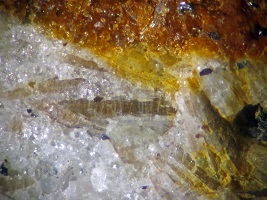
Locality: Gilsum Rd.,Surry, NH
Specimen Size: 5 mm field of view. Glassy tan blades of anthophyllite in quartz.
Field Collected: Tom Mortimer
Catalog No.: 2092
Notes: Identification method: A semi-quantative polished grain EDS analysis.
Anthophyllite and cummingtonite are dimorphs, that is, they are distinct species with the same chemistry but different crystal structure. I was hoping for cummingtonite because, 1) visually this fit, 2) I did not have a NH cummingtonite, and 3) cummingtonite had been reported from the adjacent town of Walpole.
Ideal anthophyllite-cummingtonite chemistry is Mg7Si8O22(OH)2 . Iron and aluminum are usual substitutes. The Handbook of Mineralogy gives a cummingtonite analysis of (Mg4.44Fe2.02Al0.46Ca0.20Na0.18Ti0.03Mn0.03)Σ=7.20(Si7.36Al0.64)Σ=8.00O22(OH)2.5 .
A January 2018 polished grain analysis (BC263 set 18) from this specimen gave:
(Mg3.35Fe1.83Al0.21Na0.46)Σ=6.27(Si8)O3.57, normalized for 8 atoms of Si. A suspect Na contamination issue with the carbon coat solvent may overstate the sodium content. The oxygen content is very low, but we frequently have issues quantifying oxygen. This analysis strongly suggests the species is anthophyllite-cummingtonite, but does not resolve the dimorph ambiguity.
A December 2018 XRD analysis yielded a convincing identification of anthophyllite. Additionally, an optical examination with a polarizing microscope by Matt Butler supported the anthophyllite ID. Matt reported: "lots of elongated light brownish xls that have a definite shape / cleavage. I used a moistened toothpick to move 6 of these to a slide and prepared them with a drop of oil and coverslip - aka the "grain mount". All 6 samples are elongated / kind of tabular that naturally lay on a xl face / cleavage and show good interference colors and all have exactly parallel extinction - the xl goes extinct (dark) whenever the long xl face / cleavage is parallel to one the crosshairs of the crossed polarized filters. Just to be sure I mounted 2 xls to my homemade spindle stage needle so I could rotate it 180 degrees under the PLM and got the same results - parallel extinction. So, assuming I did everything correctly, the parallel extinction means the orthorhombic system so this must be anthophyllite not cummingtonite."
Locality: Gilsum Rd.,Surry, NH
Notes: Gedrite and massive cordierite are also present in this outcrop.
Locality: Gilsum Rd.,Surry, NH
Specimen Size: 4.5 cm specimen. Gray anthophyllite blades in quartz
Field Collected: Tom Mortimer
Catalog No.: 2092
Notes:
Locality: Gilsum Rd.,Surry, NH
Specimen Size: 2 cm field of view. Gray anthophyllite blades in quartz.
Field Collected: Tom Mortimer
Catalog No.: 2092
Notes:

Locality: Gilsum Road ledge, Surry, NH
Specimen Size: 10 cm specimen with 3 cm anthophyllite crystal spray in quartz.
Field Collected: Tom Mortimer
Catalog No.: 1615
Notes: I had this specimen labeled as gedrite for many years, as this amphibole had been identified from this locality by a professional geologist, (see Surry gedrite reference ). However, the confirmation of anthophyllite (specimen 2092, above, by EDS, XRD, and optics) indicated a need to confirm this and other specimens from this site.
A December 2018 polished grain analysis (BC317 set 22) from this specimen gave:
(Mg4.90,Fe1.82)Σ=6.72Si8O15.3, normalized for 8 atoms of Si.
A follow-up polished grain EDS analysis (BC493 set 35) from this specimen gave:
(Ca0.24)(Fe2.7)Σ=2.7(Mg4.40Al0.39Fe0.21) Σ=5.0(Si7.75Al0.25)Σ=8.0O24 normalized for 24 atoms of O. Mg > Fe, but this is a very high Fe content for anthophyllite.